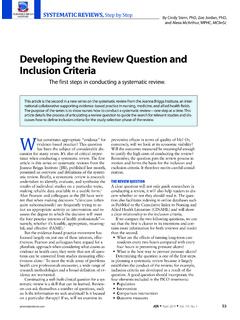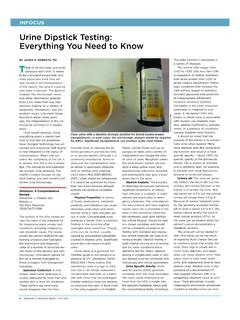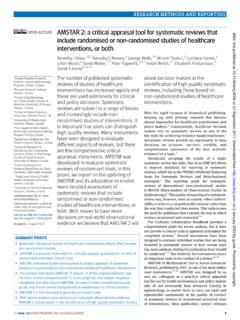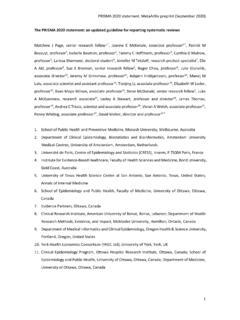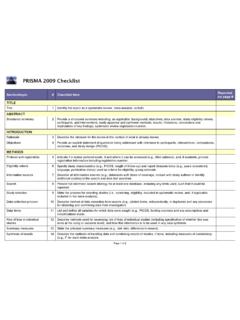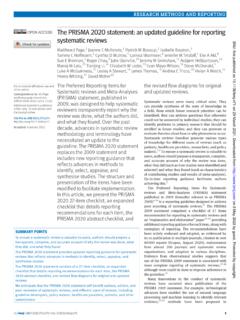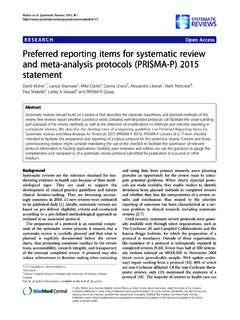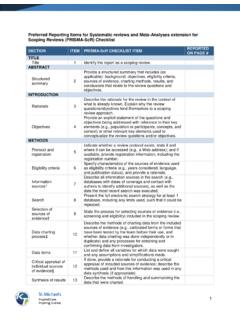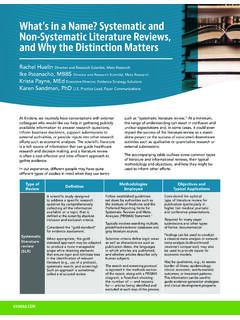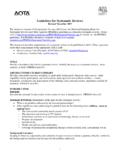Transcription of The Systematic Review: An Overview
1 AJN March 2014 Vol. 114, No. 3 53 Systematic REVIEWS, Step by StepThe Systematic review : An OverviewSynthesizing research evidence to inform nursing in the health sciences has provided all health care professions, including nurs-ing, with much new knowledge to inform the prevention of illness and the care of people with ill health or trauma. As the body of research has grown, so too has the need for rigorous syn-theses of the best available evidence. Literature reviews have long been a means of sum-marizing and presenting overviews of knowledge, cur-rent and historical, derived from a body of literature. They often make use of the published literature; gen-erally, published papers cited in a literature review have been subjected to the blind peer- review process (a hallmark of most scientific periodicals). The litera-ture included in a literature review may encompass research reports that present data, as well as concep-tual or theoretical literature that focuses on a An author may conduct a literature review for a variety of reasons, including to1 present general knowledge about a topic.
2 Show the history of the development of knowledge about a topic. identify where evidence may be lacking, contra-dictory, or inconclusive. establish whether there is consensus or debate on a topic. identify characteristics or relationships between key concepts from existing studies relevant to the topic. justify why a problem is worthy of further of these purposes have been well served by a traditional or narrative review of the litera-ture. Traditional literature reviews, though useful, have major drawbacks in informing decision mak-ing in nursing practice. Predominantly subjective, they rely heavily on the author s knowledge and experience and provide a limited, rather than exhaus-tive, presentation of a Such reviews are often based on references chosen selectively from the evi-dence available, resulting in a review inherently at risk for bias or Systematic error. Traditional litera-ture reviews are useful for describing an issue and its underlying concepts and theories, but if conducted according to no stated methodology, they are diffi-cult to reproduce leaving the findings and conclu-sions resting heavily on the insight of the , 2 In many cases, the author of the traditional review discusses only major ideas or results from the stud-ies cited rather than analyzing the findings of any single study.
3 With the advent of evidence-based health care some 25 years ago, nurses and other clinicians have been expected to refer to and rely on research evi-dence to inform their decision making. The need for evidence to support clinical practice is constantly on the rise because of advances that continually expand the technologies, drugs, and other treatments avail-able to Nurses must often decide which strategies should be implemented, yet comparisons between available options may be difficult to find because of limited information and time , particu-larly among clinical staff. Furthermore, interpreting research findings as presented in scientific publica-tions is no easy task. Without clear recommenda-tions for practice, it can be difficult to use evidence appropriately; it requires some knowledge of statis-tics and in some cases extensive knowledge or ex-perience in how to apply the evidence to the clinical Also, many health care devices and drugs come with difficult-to-understand claims of As a result of research, the knowledge on which nursing care is based has changed at a rapid pace.
4 By Edoardo Aromataris, PhD, and Alan Pearson, PhD, RNThis article is the first in a new series on Systematic reviews from the Joanna Briggs Institute, an interna-tional collaborative supporting evidence-based practice in nursing, medicine, and allied health fields. The purpose of the series is to show nurses how to conduct a Systematic review one step at a time . This first installment provides a synopsis of the Systematic review as a scientific exercise, one that influences health care decisions. 54 AJN March 2014 Vol. 114, No. 3 REVIEWS, Step by StepThis inexorable progress means that nurses can ac-cess biomedical databases containing millions of ci-tations pertinent to health care; these databases are growing at a phenomenal rate, with tens of thousands of publications added every year. The volume of litera-ture is now too vast for nurses and other health care professionals to stay on top Furthermore, not all published research is of high quality and reliable; on the contrary, many published studies have used inap-propriate statistical methods or have otherwise been poorly conducted.
5 Such issues affecting research quality can make for research findings that are contradictory or inconclu-sive. Similarly, using the results of an individual study to inform clinical decision making is not advisable. When compared with other research on the topic, a study may be at risk for bias or Systematic Therefore, it can be difficult for nurses to know which studies from among the multitude available should be used to inform the decisions they make every day. As a result, reviews of the literature have evolved to become an increasingly important means by which data are collected, assessed, and Systematic review Since the traditional literature review lacks a formal or reproducible means of estimating the effect of a treatment, including the size and precision of the es-timate,2, 7 a considerably more structured approach is needed. The Systematic review , also known as the research synthesis, aims to provide a compre-hensive, unbiased synthesis of many relevant stud-ies in a single , 7, 8 While it has many of the characteristics of a literature review , adhering to the general principle of summarizing the knowl-edge from a body of literature, a Systematic review differs in that it attempts to uncover all of the evidence relevant to a question and to focus on re-search that reports data rather than concepts or , 9As a scientific enterprise, a Systematic review will influence health care decisions and should be con-ducted with the same rigor expected of all research.
6 Explicit and exhaustive reporting of the methods used in the synthesis is also a hallmark of any well-conducted Systematic review . reporting standards similar to those produced for primary research de-signs have been created for Systematic reviews. The PRISMA statement, or preferred reporting Items for Systematic Reviews and Meta-Analyses, pro-vides a checklist for review authors on how to re-port a Systematic Ultimately, the quality of a Systematic review , and the recommendations drawn from it, depends on the extent to which methods are followed to minimize the risk of error and bias. For example, having multiple steps in the Systematic review process, including study selection, critical appraisal, and data extraction conducted in duplicate and by independent reviewers, reduces the risk of subjective interpretation and also of in-accuracies due to chance error affecting the results of the review . Such rigorous methods distinguish Systematic reviews from traditional reviews of the characteristics of a Systematic review are well defined and internationally accepted.
7 The following are the defining features of a Systematic review and its conduct: clearly articulated objectives and questions to be addressed inclusion and exclusion criteria, stipulated a pri-ori (in the protocol), that determine the eligibil-ity of studies a comprehensive search to identify all relevant studies, both published and unpublished appraisal of the quality of included studies, assess-ment of the validity of their results, and reporting of any exclusions based on quality analysis of data extracted from the included re-search presentation and synthesis of the findings ex-tracted transparent reporting of the methodology and methods used to conduct the review Different groups worldwide conduct Systematic reviews. The Cochrane Collaboration primarily addresses questions on the effectiveness of interven-tions or therapies and has a strong focus on synthe-sizing evidence from randomized controlled trials It can be difficult for nurses to know which studies from among the multitude available should be used to inform the decisions they make every AJN March 2014 Vol.
8 114, No. 3 55(RCTs) (see ).9 Other groups such as the Centre for Reviews and Dissemina-tion at the University of York ( ) and the Joanna Briggs Institute ( ) include other study designs and evidence de-rived from different sources in their Systematic re-views. The Institute of Medicine issued a report in 2011, Finding What Works in Health Care: Stan-dards for Systematic Reviews, which makes recom-mendations for ensuring objective, transparent, and scientifically valid reviews (see 1cRIAg7). How Systematic reviews are conducted may vary; the methods used will ultimately depend on the question being asked. The approach of the Co-chrane Collaboration is almost universally adopted for a clear-cut review of treatment effectiveness. How-ever, specific methods used to synthesize qualitative evidence in a review , for example, may depend on the preference of the researchers, among other The steps for conducting a Systematic review will be addressed below and in greater detail through-out this question and inclusion criteria.
9 System-atic reviews ideally aim to answer specific questions, rather than present general summaries of the litera-ture on a topic of , 8 A Systematic review does not seek to create new knowledge but rather to synthesize and summarize existing knowledge, and therefore relevant research must already exist on the , 5 Deliberation on the question occurs as a first step in developing the review , 7 Nurses ac-customed to evidence-based practice and database searching will be familiar with the PICO mnemonic (Population, Intervention, Comparison intervention, and Outcome measures), which helps in forming an answerable question that encompasses these con-cepts to aid in the , 8, 11 (The art of formulating the review question will be covered in the second ar-ticle of this series.)Ideally, the review protocol is developed and pub-lished before the Systematic review is begun. It details the eligibility of studies to be included in the review (based on the PICO elements of the review question) and the methods to be used to conduct the review .
10 Adhering to the eligibility criteria stipulated in the re-view protocol ensures that studies selected for inclu-sion are selected based on their research method, as well as on the PICO elements of the study, and not solely on the study s Conducting the review in such a fashion limits the potential for bias and re-duces the possibility of altering the focus or boundar-ies of the review after results are seen. In addition to the PICO elements, the inclusion criteria should spec-ify the research design or types of studies the review aims to find and summarize, such as RCTs when an-swering a question on the effectiveness of an inter-vention or Stipulating study design as an extra element to be included as part of the inclu-sion criteria changes the standard PICO mnemonic to PICOS. Searching for studies can be a complex task. The aim is to identify as many studies on the topic of interest as is feasible, and a comprehensive search strategy must be developed and presented to , 10 A strategy that increases in complexity is common, starting with an initial search of major databases, such as MEDLINE (accessed through PubMed) and the Cumulative Index to Nursing and Allied Health (CINAHL), using keywords derived from the review question.
